So, I’ve admired Cory Arcangel’s work, more or less. Maybe I just really enjoy the seduction of Super Mario Clouds. I had prints once. And I have the little blue artist’s book somewhere. The one with the embossed blue clouds. I didn’t know about the show at The Whitney Museum until I was back home and happened across mention of it in an issue of New York Magazine laying around the house. I was determined to see it before I left, which would be complicated by obligations and promises to myself and other things. But — I’d do it. That and the ICP’s Elliot Erwitt exhibition.
ICP first, then uptown and over east to The Whitney. $18 USD and I was in. I just went straight to the 4th where Arcangel had the entire floor. They allowed photography by special dispensation, so that’s always exciting. I never really understood — in this day and age — the no-photography thing in museums. I guess it’s so people don’t stand around taking photographs of art instead of just looking at it. In any case, you could take photographs at Arcangel’s exhibition.
First thing, you’re inundated with the cacocophony of a bunch of retro bowling games projected ginormously against a wall. Okay. Seems Arcangel-y. The 8-bit video game thing. Seen this stuff. I guess most of America has not. I watched and *shrugged and figured I needed to get warmed up. Around the corner so fuck-off big C-Prints of Photoshop gradients and the like. I was told I should appreciate these cause it’s, like..I dunno..something anyone can do? And it’s digital? And now, like..it’s a C-Print that’ll last longer than something-or-another..time? Or, like..who knows? Maybe it’ll be important cause it’s a C-Print of something art-y in an ironic, Williamsburg-y sorta way..like painting a painting on a painting canvas that’s all white? Or maybe black or whatever happened back then.
*Disappointed.
Then there was the pitch of astroturf and a golfing game. And a couple of chairs and a guy listening to something about the show I guess and taking an iPhone photo of one of the C-Prints.
Oh. That’s why they don’t want people taking photos in museums? So, like..you don’t sit there taking photos of things in museums while just sitting there?
*Whatev. Still not feeling it.
Next room. A bunch of unopened boxes of big commodity flat screens with lots of trandemark technology logos like Bluetooth and crap all over them. This is when I started reading the wall text of the pieces of art. That were, like..the art exhibition wall text equivalent of those business books with the long titles that basically explain what you’re supposed to know about by the time you’ve finished reading the book. In this case, the wall text was so didactic and explanatory — that I got the sinking feeling that, had this been a movie? It would’ve been a movie in which the ushers would be waiting to explain to you what you just saw, with the assumption that you’d have no idea otherwise.
*That’s sad.
There was a tape loop of Seinfeld episodes — the one’s in which Kramer invites the coffee table coffee book. More wall text explaining why the hell this is art (besides the fact that an artist made it). It was sad wall text. Like..wall text for the shake weight that explains why you should be buying it to help you “get fit” in case you thought it was an erotic massage toy. What I saw? What I saw was an assembly of Seinfeld out-takes that I might expect to see when Ken Burns does the epic documentary of late 20th century American comedy television. It’s just outtakes. You laugh only because you remember laughing while you were watching it for real on your own sofa (if you laughed) but you certainly forget you’re standing around in The Whitney.
*Feeling anxious about the $18.
Then there was a screening room with a barely tolerable assemblage of YouTube excerpts of guys rocking the guitar with each clip containing a note or passage from a Paganini riff that metal-y guitarist use to exhibit their prowess on the guitar. I get it. It’s a coherent collage of lots of YouTube videos of lots of YouTubers doing the same thing only they’re all different dudes with different guitars in different bedrooms, with..&c.
*Sigh.
And that’s it. I expected something else. The retro thing feels well played out, I have to say. 8-bit is as exciting as those hipsters shooting with film cameras or using typewriters. Video of 90’s sitcoms is just video of 90’s sitcoms. Like being a dude with no cable at home but now you’re sitting in a Hampton’s Inn with jetlag, flipping the channels and you come across the 90’s channel. That’s not fun. And boxes of commodity television sets? I mean..Not sure what to do with that.
I feel like I lost a twenty dollar bill. I’m glad I didn’t rush the ICP. It was well-worth the time dawdling over the lovely photography, even if I had to rush The Whitney.
Why do I blog this? Cause I went there and it made me think about work that I had a thing for but now it seems that 10 years later it’s not the same thing and it’s more tiresome on my brainball. I like the idea of canning stuff from 10, 15, 20 years ago and then pointing to the can and saying what the contents says about “today” or how it’s a little timecapsule of yesteryear and we have a connection to those moments. But it’s more our connection than an artists/artistic translation of those things. And the other thing is? The other thing is that institutional art struggles and will continue to struggle with giving the network’s toys and the industrialists’ toys a place to live in a white-walled space. Youtube in a museum viewing closet all big like that? It’s something else and it’s not quite what is sold on the wall text, which hyperintellectualizes the medium. Same thing with 8-bit bowling games (and just watching 8-bit bowling games). It’s excruciating in a way to not be able to fiddle with it. And to see them on 16 foot walls.
Continue reading Cory Arcangel Show At The Whitney As Evidence That Retro Is As Dead As Disco
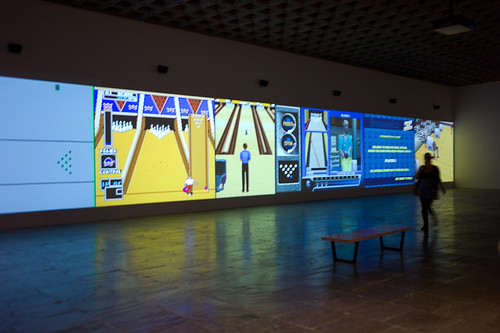
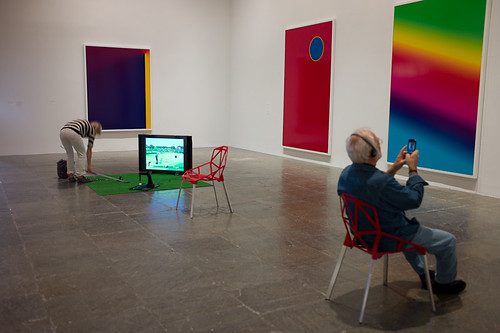
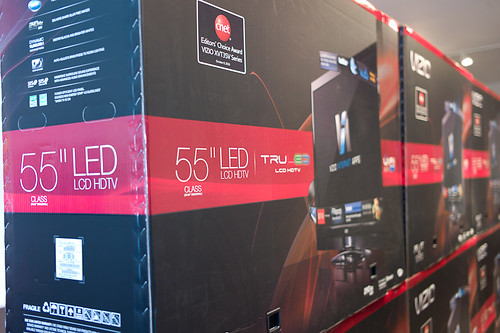

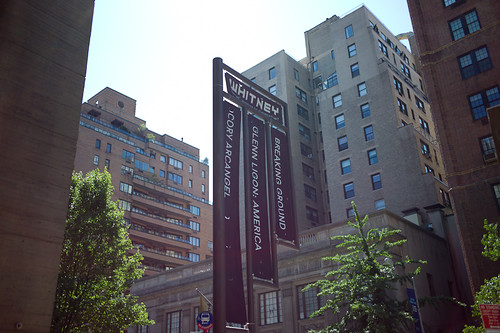

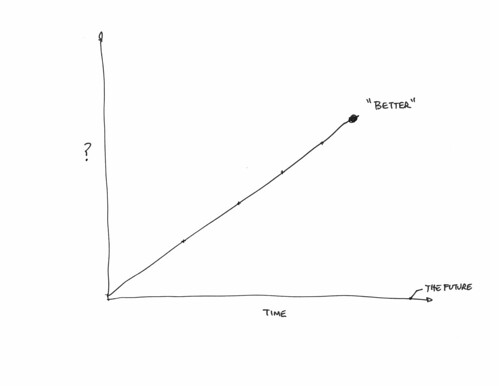


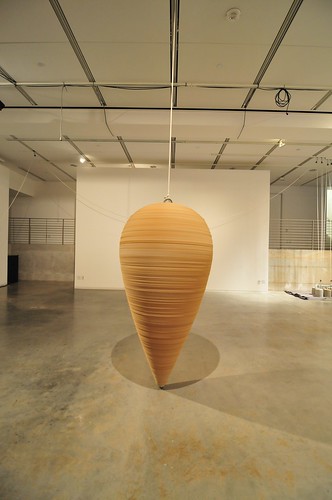
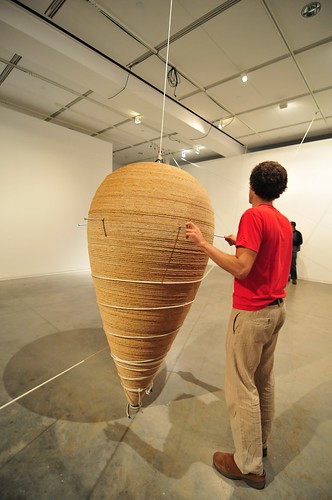



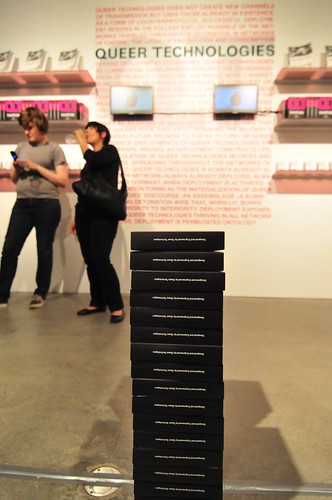
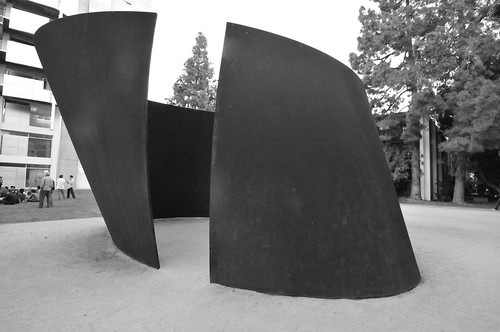
The guy reaches his stop and gets off, leaving his news cloud behind. I love watching the way these clouds break up, little wisps of information trailing off like a flickering tail, a dragon’s tail of typewriter keys and wind chimes, those little monochrome green cloudlets, a fog of fragments and images and words. On busy news days, the entire city is awash in these cloudlets, like fifty million newspapers brought to breathing, blaring life, and then obliterated into a sea of disintegrating light and noise.